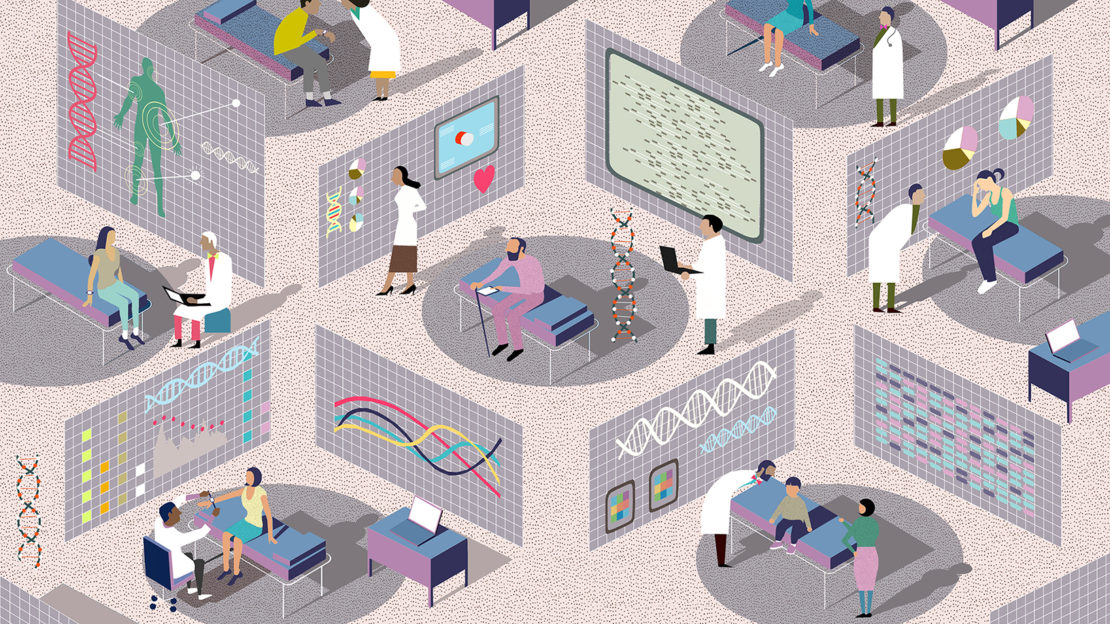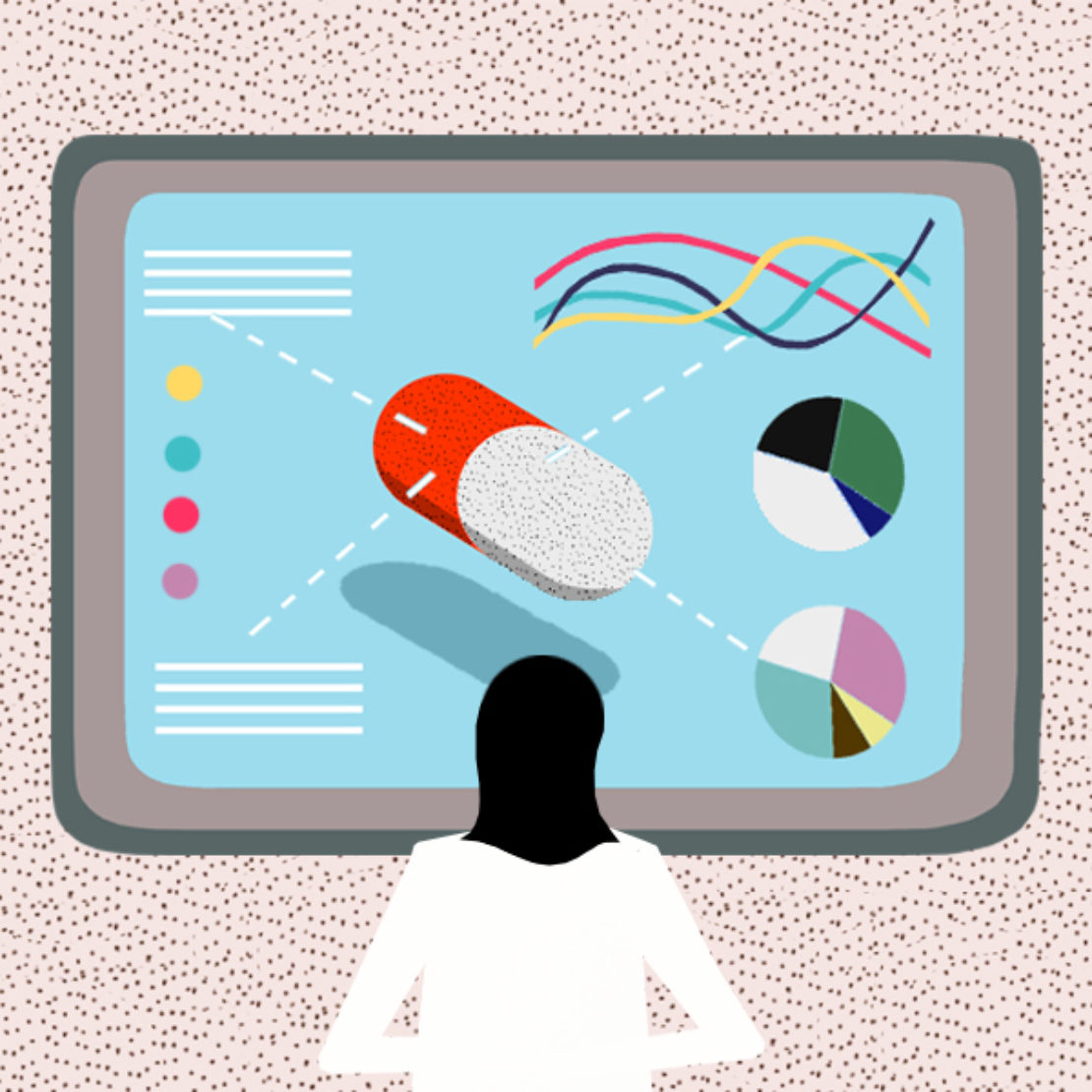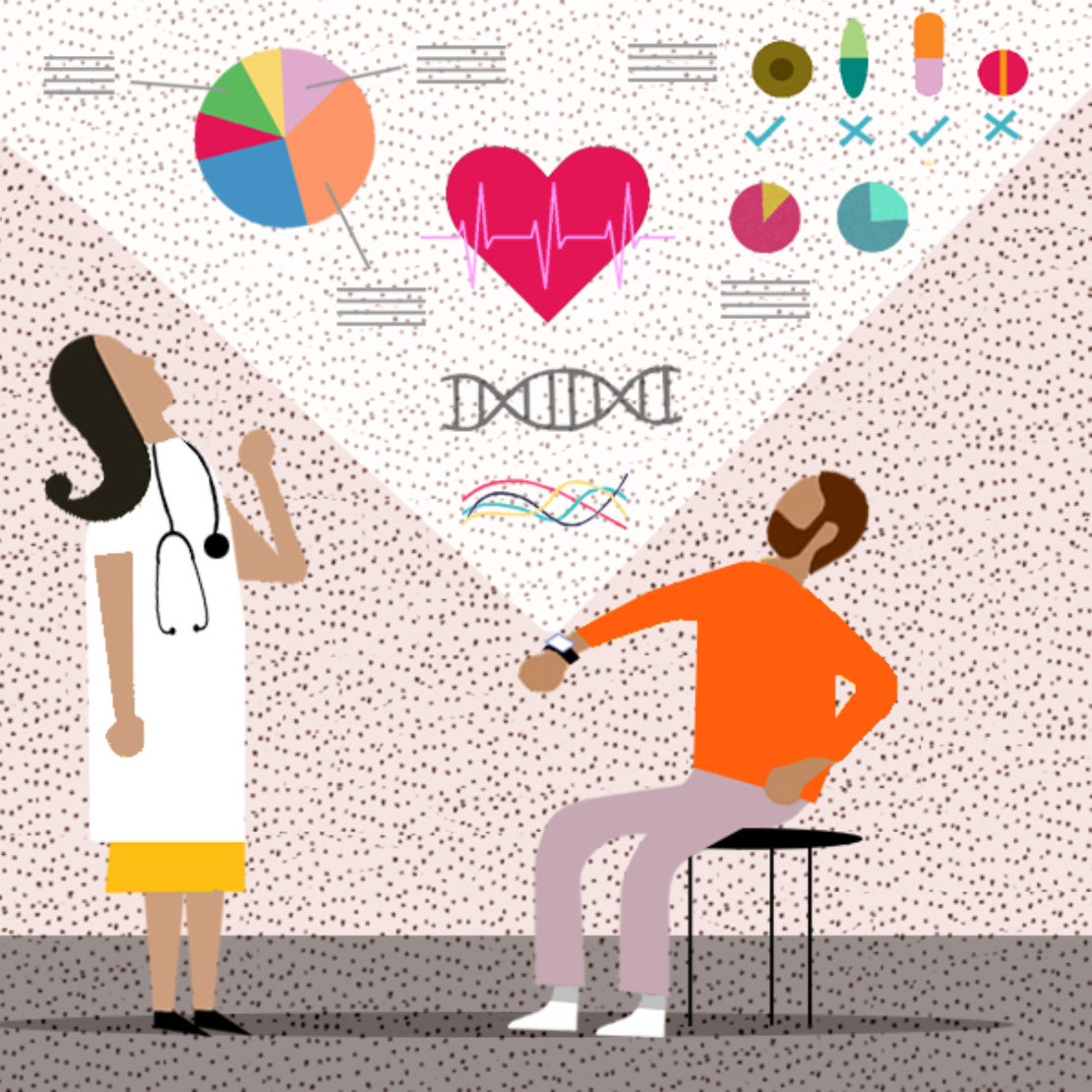
Strength in numbers
The year is 2027. Dorothy visits her GP about panic attacks she's been getting at work. Before prescribing any treatment, the doctor looks at her genetic history for markers that could affect her response to certain drugs. The GP is looking in particular for CYP2C19 polymorphism, which would mean Dorothy can't metabolise a group of medicines (SSRIs); and at the same time, she examines her patient's sequenced DNA to see if she carries the genetic mutation responsible for panic disorder. Dorothy is a heavy drinker and her doctor sees that she carries a risk gene for alcohol dependence. She considers a drug that could modulate the gene. Dorothy leaves with a smartwatch to log her daily life for the next week: her quality of sleep, diet, exercise, stress, mood and activity.
In the room next door, Fred is talking to a specialist about his Parkinson's symptoms. He was prescribed a drug recently for the subtype of Parkinson's he has and, for the first time, there were no side effects. In the past, Fred and the specialist used trial and error to find the right medication. But ever since computers have been able to process exabytes of data, scientists have found patterns and trends that allow them to treat Parkinson's with greater efficiency. Better still, through using an app on his phone, Fred has realised that taking his medicine at night affected his sleep; so he's started taking it at lunchtime instead.
Each patient is unique, so ultimately the treatment should be unique, too
Valerie has a migraine again. Like many young people these days, she had her DNA sequenced for her 18th birthday and discovered that she's one of the 7 per cent of Europeans who can't convert codeine into morphine. She inherited her response to the drug from her mother. Valerie knows to mention this to her doctor who prescribes her a non codeine-based painkiller. The doctor also considers what impact Valerie's gut flora and microbiome might have on medication.
At its simplest, precision medicine is ultra-tailored healthcare. When President Obama announced the Precision Medicine Initiative in 2015, he put it this way: "delivering the right treatments, at the right time, every time, to the right person."
Precision medicine, also known as personalised medicine, is being heralded as the next major breakthrough in healthcare. In Britain, the NHS is "on a journey towards embedding a personalised medicine approach into mainstream healthcare."
While medical care has always been tailored to the individual to an extent, the degree to which it can be personalised today is unprecedented because of new technology. Equipment that would have been the stuff of science fiction 20 years ago is now available in many universities. Three key advancements combine to make medicine more precise: patient-generated data through smartphones and wearable tech, genomic medicine and computer science.
First, patients can quickly and easily log their daily symptoms with apps on their phones or wearable technology to understand their illnesses better. Detailed records also aid doctors in the way they treat patients and provide data for research.
Second, technology is allowing us to sequence DNA at a faster rate and a cheaper cost than ever before; and scientists are understanding the genetic markers of disease at a significant rate. Estimates suggest the cost of sequencing the very first genome could have been as high as $1bn. By 2016, the cost had dropped below $1,500. The process now takes hours rather than weeks.
Third, in the age of big data, computers are allowing scientists to analyse vast amounts of data with greater precision than ever before. Machine-learning algorithms accelerate analysis of data sets which result in rapid discoveries.

Precision medicine is charged by a need to address the sheer variety of people's reactions to things going wrong in their bodies. From neurological disorders to strokes, cancer to depression, infections to alcoholism, each patient is unique; so ultimately the treatment should be unique, too.
Parkinson's is one of the first diseases precision medicine is being applied to. It's a heterogeneous disease, which means there is a lot of variability in how patients progress. In its early stages, the disease can manifest itself with symptoms very different from the tremors most associated with it. Patients may have motion-related issues with walking, posture or movement of the fingers; but they may also experience cognitive and memory problems, depression or lose their sense of smell. Because the early signs are so varied, it is difficult to predict the progression in individual patients.
Dr Duygu Tosun-Turgut of the University of California won the 2016 data challenge set by the Michael J Fox Foundation for Parkinson's research. Her aim was to discover whether the progression rate of Parkinson's disease could be predicted. If doctors could predict the speed of a patient's decline, it could affect both treatment and prognosis. It would also assist with clinical trials, as it is better to recruit patients in swift rather than slow decline. In these patients, changes and improvements – and therefore efficacy of treatment – are demonstrated more dramatically.
To define the progression rate, Dr Tosun and her team looked at all the clinical data available, captured from multiple patient visits to clinics. This included, for example, the results of memory tests, the total number of times patients could sit down and stand up over a 30-second period or changes in sleeping habits and sense of smell. Dr Tosun then looked for a pattern using data-driven machine-learning algorithms.
Two groups were identified. One was slow progressing and the other was fast progressing. The next step was to find out if there were any baseline assessments that could be used to predict the rate of progression. At this point they looked at genetic makeup, fluid biomarkers, imaging MRI data and other factors.
"The body is a whole, everything is so connected. There might be something dominant but it affects other systems in the body. It's the same in the brain," says Dr Tosun.
Explore
Should we zap our brains to improve ourselves? Chasing 'legal highs' Can young blood combat disease?She discovered that if patients arrived with more motor-related symptoms on their first visit, they would decline faster. She also identified a brain region with degenerated white matter fibres. She found that the more degenerated the structures were in these regions, the faster the patient declined.
Data was collected from people with a family history of Parkinson's or those who exhibited early signs to see if the same measure could be used to detect the disease before the symptoms started appearing. The goal would be to intervene before the disease started to progress.
"It's very difficult to reverse neurodegeneration," says Dr Tosun. "If [a patient is] progressing fast, or if they have the markers telling us they're going to progress fast, you need to progress faster."
Now Dr Tosun has turned her focus on the earliest mechanisms that trigger neurodegeneration. If it is known what triggers the disease, there may be precautions people can take to avoid developing Parkinson's. "It can be diet, supplements, physical activity or cognitive activity," she says.
"It's very important to understand everything about that patient," says Dr Tosun. "Not just their symptoms: their environment, their background, the state of their brain and body. The more we learn about the patient, the more the we can model the disease and treatment better."
With advancements in computer science, algorithms and hardware, scientists like Dr Tosun are at the point where they can look at all the data at one time to better understand disease, health, prognosis and treatment. Finding patterns will help answer different questions.
The vast capacity of big data is crucial. Dr Beckie Port, senior research communications officer at Parkinson's UK, says, "The more people you put in your experiments, the more you can iron out some of the complexities and start to see trends, It's going to be a mammoth mission to start teasing out individual factors that could be used for personalised medicine, but it's not impossible."
Personal technology – wearable tech such as fitbits and smartphone apps – is another important element in precision medicine. It is already being used in the field of Parkinson's. uMotif is a 'patient data capture platform' that allows patients with long-term conditions to track their symptoms using an app. A patient inputs information about symptoms every day, including non-motor symptoms. How did you sleep? What's your mood like today? How about stress levels? What did you eat? How's your pain? Do you have nausea?
With this information, researchers and clinical teams can understand the disease better; and patients can have more useful conversations with their clinicians. The patient becomes an active participant rather than a spectator. "How you feel your Parkinson's is a very important thing in quality of life and good treatments," says uMotif's co-founder and chief executive Bruce Hellman.
The data capture for a major study into Parkinson's is just finishing. Over 4,221 people tracked their health for 100 days and donated the data to academic research.
Already, the feedback suggests the technology is having a positive effect on individual lives. Since using the app, Mick, a Parkinson's patient, reports feeling more assured in talking about his condition with a neurologist because he has a record of what's been happening and how he's felt. "It teaches you, 'Don't beat yourself up because you can't do what you used to do, look at what you are doing'," he says.
Through plotting her feelings each day, Sam now realises that she was managing her life with Parkinson's better that she thought. She'd been getting anxiety attacks in the morning and it suddenly dawned on her that changing taking her medication from the evening to the morning might help ease the attacks. It worked. "I'm in control of my health," she says.
"One of the problems people have," says Dr Port, "is that when they go to the doctor's they may be having a very good or bad day but it might not reflect what they're like on an everyday basis, That snapshot the specialist sees could influence [the patient's] drugs for the next six months."
"People with Parkinson's often only visit a doctor twice a year," says Hellman, "so knowing more about their health will help them to bridge the gap between health visits and better understand their symptoms. Health is done to you at the moment but in the future it should be done with you."
The 100,000 Genomes Project is planning to sequence 100,000 genomes from around 70,000 people. The largest national sequencing project of its kind in the world, it aims to create a new genomic medicine service here in the UK. At the time of writing, the 20,429 genomes that have so far been sequenced are split 50/50 between cancer and rare diseases. It covers a large geographical area: England already has 13 genomic medicine centres covering 85 NHS trusts.
"Genomic medicine is right at the vanguard of personalised medicine," says Tom Fowler, deputy chief scientist and director of public health at Genomics England. He points out the role it can play in treating rare diseases, where unmet diagnostic needs are of paramount importance. "For people with a lifetime of wondering why they or their child is affected, the benefit [of genomic medicine] is being able to answer that question. It also can improve existing or potential treatment and help with making reproduction choices."
Thanks to genomoic medicine, numerous diagnoses have been possible. The gene mutation causing four-year-old Jessica's rare disease was identified by researchers after her parents spent years not knowing what was wrong. Jessica's treatment is simply a special diet that enhances glucose production in the brain. After a month on the regime, Jessica's parents "noticed a big improvement in her speech, energy levels and general steadiness," according to consultant Maria Bitner-Glindzicz of Great Ormond Street hospital. "Overall, she is better and brighter in herself and her parents don't worry about her having fits on a daily basis as they used to."
The project anticipates a 25 per cent diagnostic rate in rare diseases but Fowler says the remaining 75 per cent don't just get put aside, the data goes into research environments where it will be worked on: "It's the start, not the end, of the journey."
A small group of Parkinson's patients is included in the 100,000 Genomes project because early onset Parkinson's is considered rare and it's more likely to contain a genetic factor. It is estimated that around 5 per cent of Parkinson's cases have a genetic link; but Dr Port thinks the role of genetics in the disease is probably a lot larger.

The challenge now is how to move this kind of healthcare into the mainstream as part of routine healthcare. Fowler hopes that will happen in the next five years. In 2015, in partnership with Health Education England, nine universities introduced master's degrees in Genomic Medicine. "A legacy of upskilling staff so they understand information will make the long-lasting difference," says Fowler. "If we build an infrastructure and workforce that can cope with genomic medicine, as new discoveries happen we've got the ability to adapt and take them on board."
Genetic testing can already reveal the potential for future illness and allow for proactive and preventative decisions. When Angelina Jolie, for example, discovered she carried BRCA1, the genetic marker for breast cancer that her late mother carried, she had a double mastectomy. People with a BRCA1 mutation have a 65 per cent chance of developing breast cancer, according to the National Cancer Institute.
At the moment the number of people who've had their genes sequenced is fractional but it could become more commonplace. Will everyone have genetic testing eventually? "At the current time it's difficult to see how that would step out into the mainstream," says Fowler. "There may well be a time where that is the case and we move towards it." The NHS wouldn't be expected to pay for that, he adds.
People are already paying to have their genes tested. Companies like 23andMe of gene testing home-kit services, which offer the possibility of finding out if you have a genetic variant that could put you at risk for certain traits or conditions. They range from serious conditions (cancer, Alzheimer's) to traits (caffeine metabolism, alcohol flush reaction, coriander aversion and sensitivity to the sound of chewing).
Critics of precision medicine say that the word 'precision' is an unrealistic, inflated, hyperbolic term. They caution that there are many things happening in the human body, as well as genetics. In the journal Clinical Pharmacology & Therapeutics, Canadian doctor Dan Roden wrote, "Patients are more than collections of genomes and gene-environment interactions; they are individuals influenced by experience, culture, education, upbringing, and innumerable other factors."
Still, there have already been some major success stories in genomic medicine. Most recently, DNA sequencing has led to a 'miracle' drug that treats spinal muscular atrophy (SMA), the most common genetic cause of death in childhood. The drug has recently been approved by the FDA.
Combined with patient-generated data and computer-powered analysis of big data, precision medicine seems like an obvious next step. It will take time and cost money but once the task of digitising healthcare is finished, it promises a slicker, more efficient system with better diagnosis and treatment.
"You can't assume everyone has average Alzheimer's, Parkinson's, or depression. They have their own properties," says Dr Tosun. "Precision Medicine is the solution, it's something we need to do."